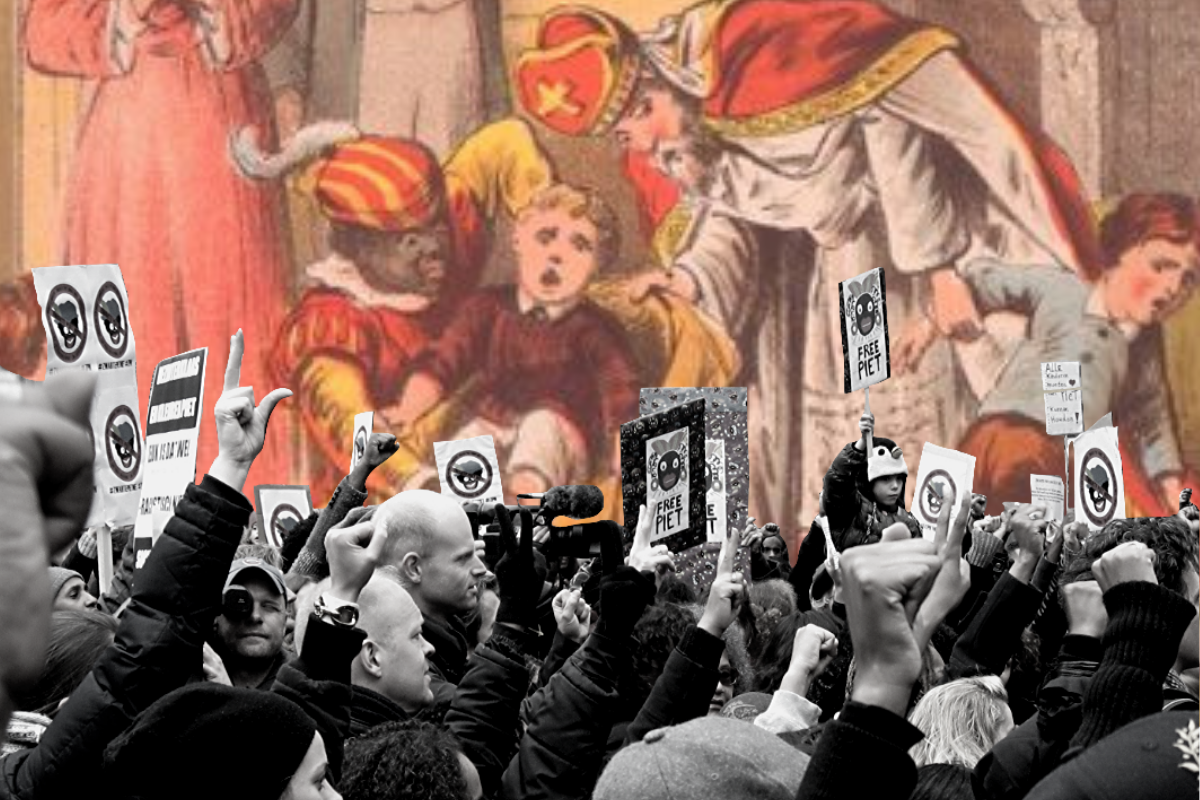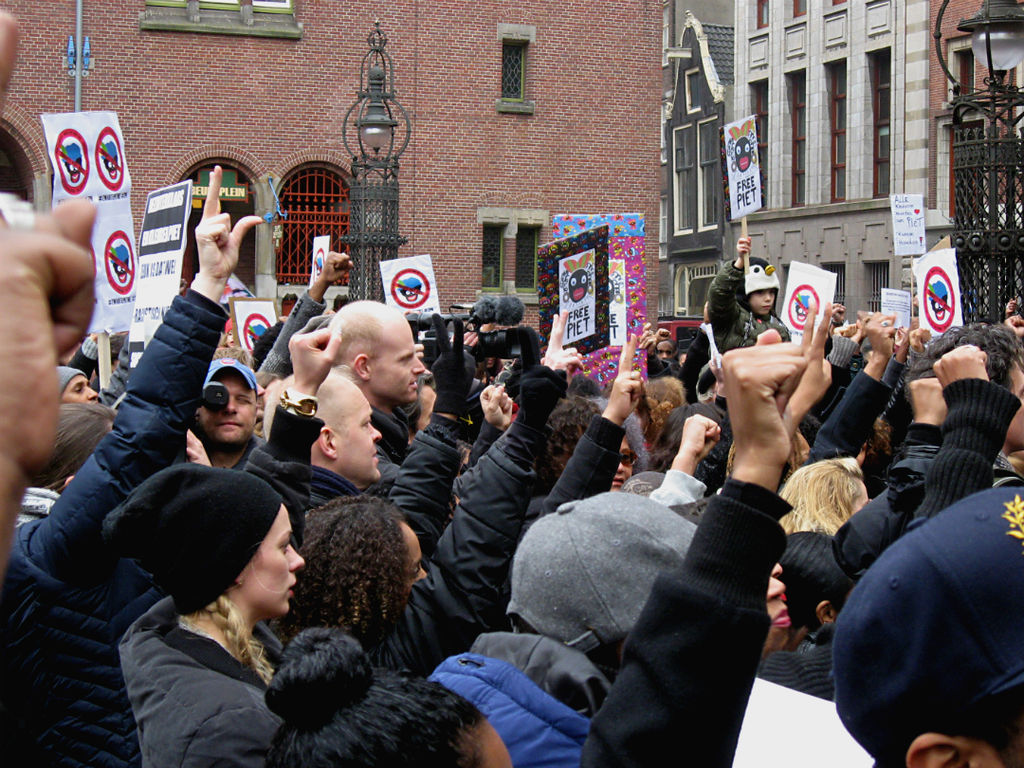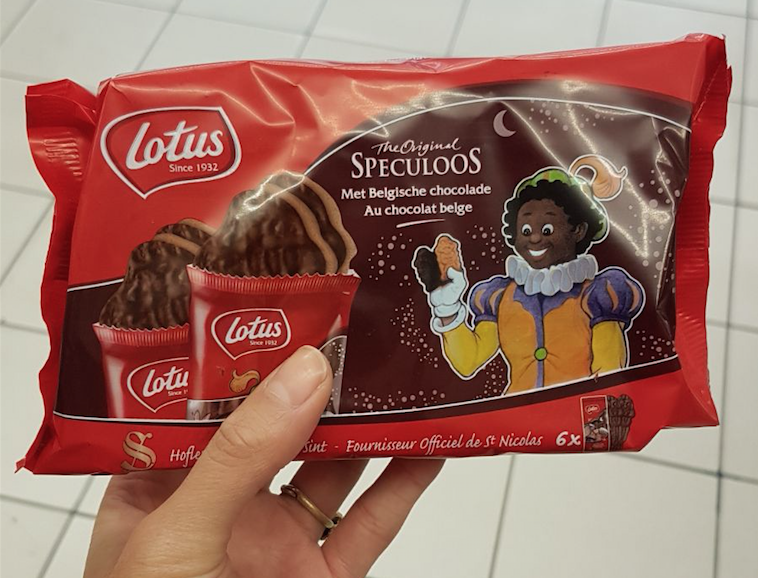
Resistance to blackface in the Netherlands is not new – so why does Zwarte Piet still exist?
Bel Parnell-Berry
05 Dec 2019
Image via Wikimedia Commons/Constablequackers
It’s Sinterklaas season again in the Netherlands, and the usual pangs of frustration around campaigning against Zwarte Piet have set in. Zwarte Piet is the demonic counterpart to Sinterklaas (Dutch Santa Claus). The character is a centuries old concept comparable to the Krampus in Germany, but with one crucial difference: the Dutch variant of Santa’s helper is a caricature of an enslaved black person. Since the 1850s, this new iteration of the character has accompanied Saint Nicholas on a steamboat each year, in order to give out gifts and sweets to expectant Dutch children.
Protests against the depiction of Zwarte Piet – who wears pitch black face paint, enlarged painted red lips, an afro wig and golden earrings – have been ongoing since the 1920s at least, accelerating in 2011, when Quinsy Gario launched his Zwarte Piet is Racisme (“Black Pete is racist”) art campaign. Since then, the slogan continues to be used by campaigners across the country, as well as in Belgium and Curaçao, where blackface continues to be used during Sinterklaas celebrations. Most notably, the organisation Kick Out Zwarte Piet (KOZP) are at the forefront of organising demonstrations and conversations about the depictions of Saint Nick’s key companion.
The Dutch Double Standard
Reflecting on the progress of the Zwarte Piet debate, activist Archana Ramanujam told me that “There are still arrests made of anti-racist activists who make the merest suggestion of violence online, whereas the hundreds of people who threaten KOZP activists and black people get minimal to no sanctioning.” Archana cited Piet proponent Jenny Douwes and Sinterklaas parade sponsor John van Zweden who, she explains, “actually called on the masses to act violently against KOZP activists.”
A study by the European Race & Imagery Foundation (ERIF) recorded that the words and actions of Jenny Douwes in 2017 (who remains unapologetic) no doubt emboldened those who went on to to use violence to prevent further anti-blackface protests in 2018 in Den Helder, Nijmegen, Zwolle and Appeldorn. The most striking of these happened in The Hague in 2018 when, due to violent threats, the University of Leiden was forced to cancel a panel discussion on Zwarte Piet at their campus.
The Afro Student Association (ASA), who had planned the event, were also forced to cancel a similar discussion event planned in 2019, following an attack on a KOZP meeting by pro-Piet racists. Levi Ommen, chair of the ASA and a student at Leiden’s The Hague campus, told me that for security reasons, the university decided that only students and staff could attend the discussion and threatened that if anyone refused to leave the campus when asked, they would immediately be arrested. Levi explained that “Most of the people on our guest-list who said they were interested in coming were people from outside of the university. [The university] were really limiting us at this point. For me, the main issue is not even that they made the decision, it’s that they didn’t even ask for our input.” The university effectively punished and restricted the ASA for the threats racists had made against them.
No justice, no peace
It has shocked many in The Hague – a self-professed international city of peace and justice – that anti-blackface campaigners have faced such vile and racist resistance to their cause. This reaction of shock exists not because anyone assumed that there would be no resistance at all, but because politically and socially, The Hague presents itself as an inclusive and progressive city where access to freedom of speech is open to all.
However diverse the city is, a white supremacist pro-Piet movement has been allowed to thrive in pockets of The Hague, encouraged by the likes of Toi van Gelder and John van Zweden, the latter of which claimed that prior to Gario’s 2011 art-protest, there had been no criticisms of Zwarte Piet. They – and others like them – prefer to believe it is only “foreigners” who have a problem, not real (read: white) Dutch people. Mikal Tseggai – of the Labour Party in The Hague – stood up to Van Zweden on TV show De Nieuwe Maan, telling him firmly that she is just as Dutch as he is. Mariam Elmaslouhi, who has been leading the KOZP demonstrations in The Hague for the last two years, agrees with this sentiment by pointing out that she and her comrades “are all second and third generation, so we’re all born and raised here.”
The willful ignorance about the lengthy history of Dutch opposition to Zwarte Piet is at the core of this so-called counter-movement. In fact, Zwarte Piet was discussed on the Dutch Sesame Street – in terms of race relations no less – back in 1987 by TV presenter Gerda Havertong. Dutch decolonial scholar Karlijn Völke has been researching the history of resistance to Zwarte Piet in the Netherlands, and told me the story of a black man who appeared in a Rotterdam court in 1927. The man had punched a harbour worker for calling him “Zwarte Piet” and he explained to the judge that this happens to black people all of the time.
Out of the four largest cities in the Netherlands (also including Amsterdam, Rotterdam and Utrecht), The Hague is the only one that has not yet removed blackface entirely from its annual Sinterklaas parade. To address this, Mariam led a campaign this year, calling upon sponsors of the parade in The Hague to withdraw their funding if the city did not promise to remove the Zwarte Piet character. The campaign did result in some sponsors removing their investments, but was also met with backlash from John Van Zweden and others, with Mariam telling me that “The head organiser of the parade said he is getting threats from pro-Pieters”. Mariam told me that in the aftermath of the campaign calling on sponsors to withdrawn their support, she got death threats.
Social cohesion vs. social inclusion
One might argue that such aggressive outbursts towards Dutch people of colour – who are attempting to make the Netherlands more inclusive – accelerates social exclusion. Thinking about this, Levi remarked that “People say whatever they want and then say it’s about freedom of speech. [We’re expected to] accept hate speech because people need to be able to say whatever they want.” The lack of political will to speak out against both this imbalance of freedom of speech as well as the physical violence that has taken place against anti-blackface campaigners is a hindrance to moving forwards on this issue.
Referring to the 2019 break-in and attack on a KOZP meeting, Archana explained that, “Many politicians have remained absolutely silent on the violent break-in and [failed] to denounce violence in our society, and racist violence specifically.” Levi, who was at that meeting, explained, “We were having a meeting, which is our right according to article 9 of Dutch law, and trying to prevent this in such a violent way is terrorism. [Politicians are] responding in a neutral way. We can’t do that!” Addressing an audience at the International Institute of Social Sciences on the 15th November, Dutch professor Gloria Wekker compared Prime Minister Mark Rutte’s neutral response, which has also been criticised directly by KOZP, to Donald Trump’s response to the racist violence in North Carolina in 2017.
Nonetheless, Mariam feels that the authorities are learning, albeit slowly, and told me that the police received wide criticism in 2018, including from Amnesty International, after failing to deal with the violence targeted at anti-Zwarte Piet protestors. Levi adds, “They use sooty Piet [instead of full blackface] right now, which is something very positive. It’s showing the way we’ve been protesting, the work that we’ve been doing has a positive effect for us.” Cautiously reflecting on the progress of KOZP, Mariam concluded: “We’re still operating on the margins. Even though we had all that media attention, there were still only 900 people out there [protesting at the Sinterklaas parade in The Hague, in 2019]. Where is the rest of the 16 million? I think black people are going to get more organised – we’ve learned a lot in the last couple of years.”
Attempts to end racism and xenophobia in the Netherlands are thwarted by cultural gaslighting, masquerading as calls for social cohesion – what the Dutch call gezelligheid. It is clear that in the white Dutch imagination, a black person – regardless of where they were born or grew up – can never really be Dutch and therefore has no place attempting to change a Dutch tradition so ingrained as Sinterklaas. The explosions of racist violence witnessed in recent years, the tone-and-literal policing of the discussion and the overall resistance to evolve is proof that this belief is so deeply rooted. This Dutch white nativist fantasy which seeks to cling onto the symbol of Zwarte Piet has the impact of explicitly excluding people of colour from becoming a true part of the fabric of the society.






